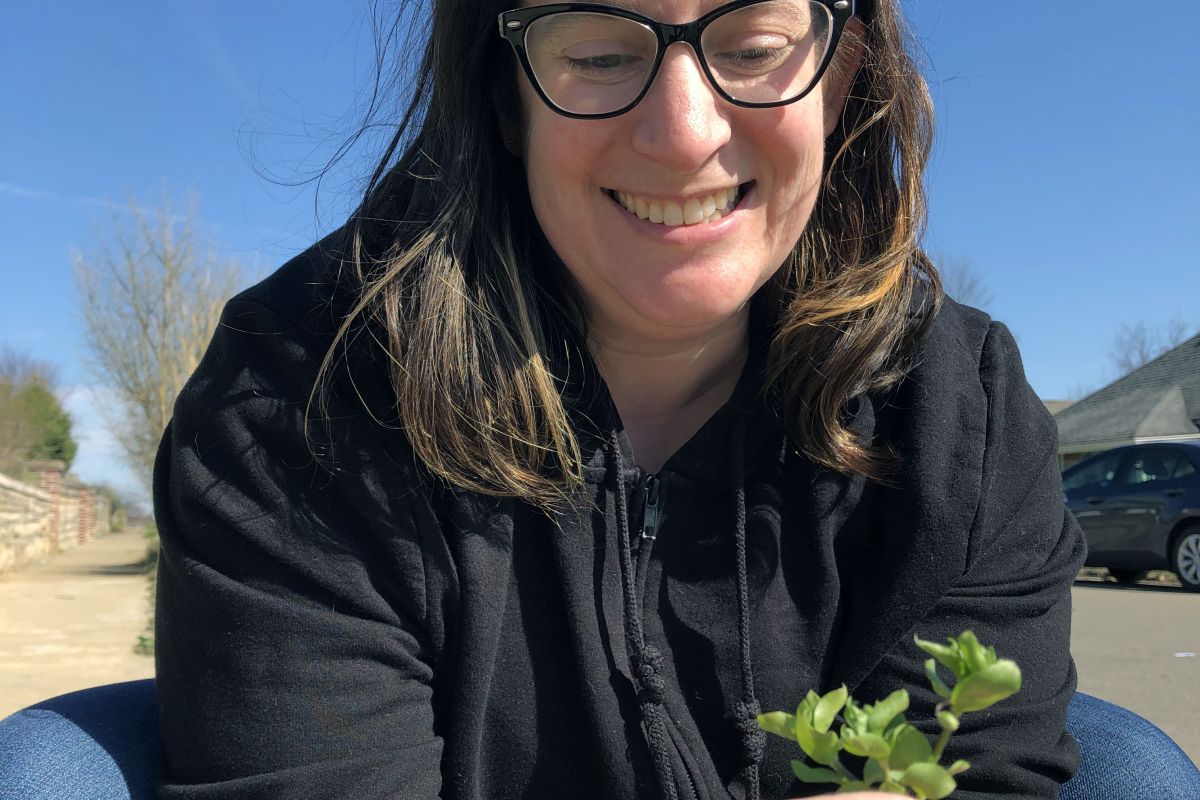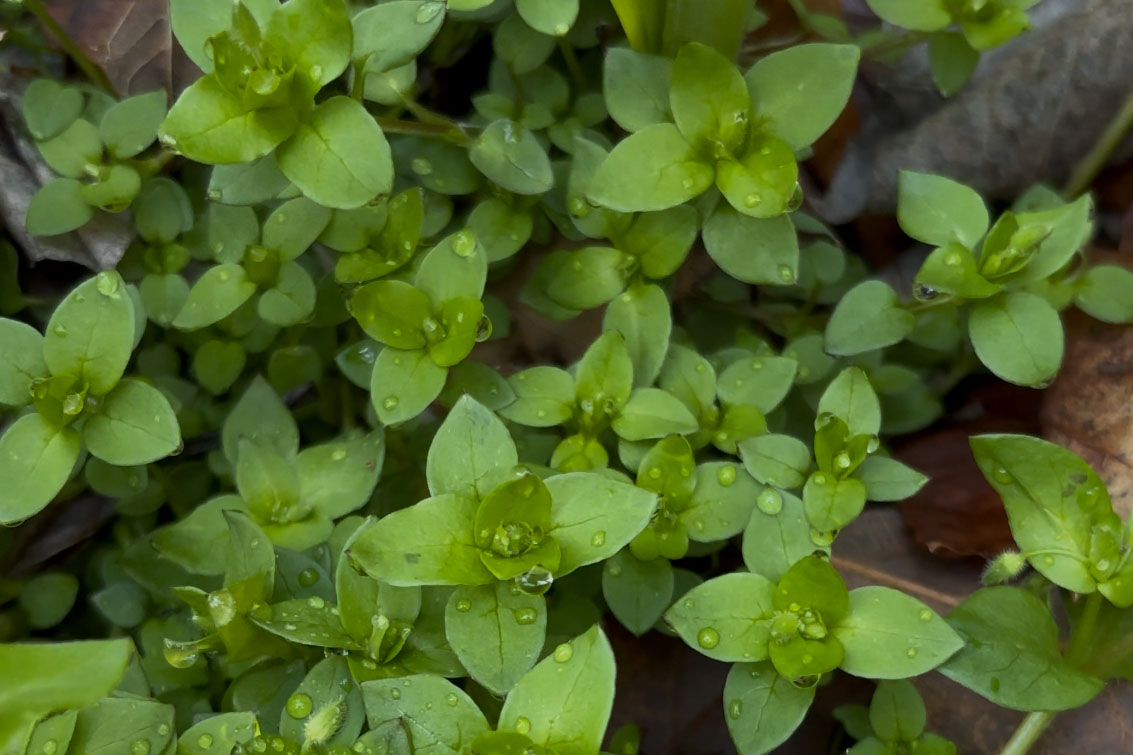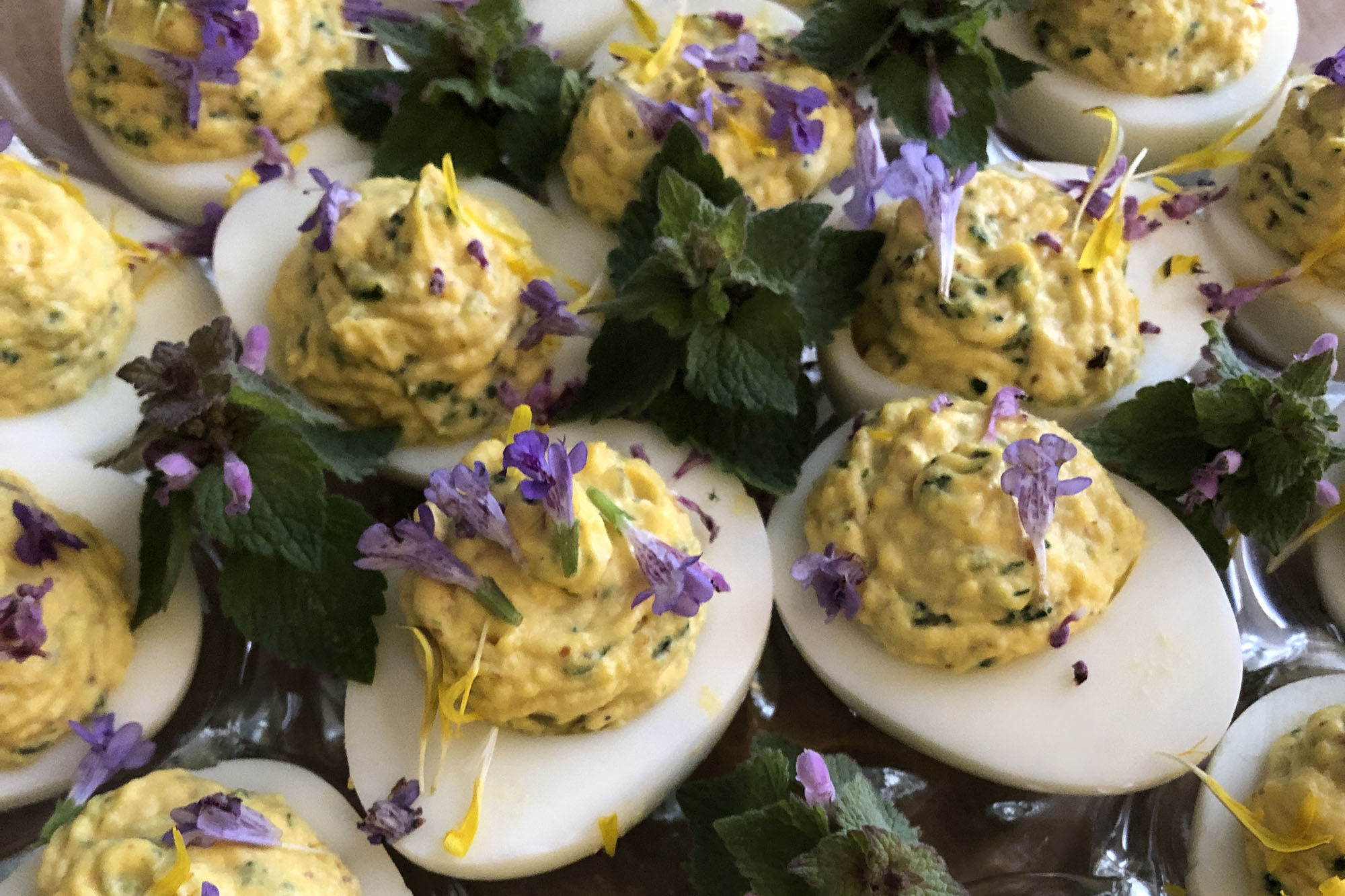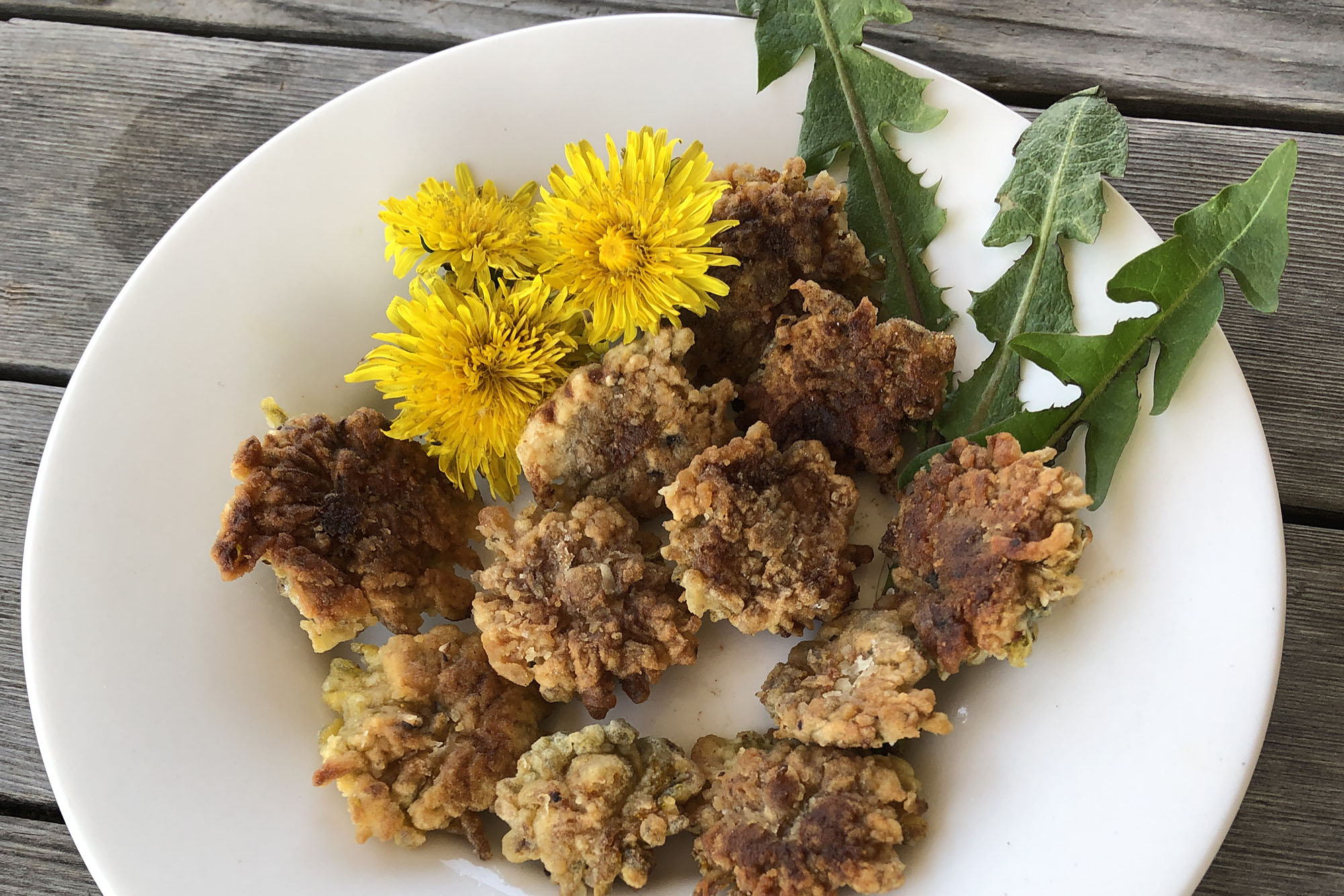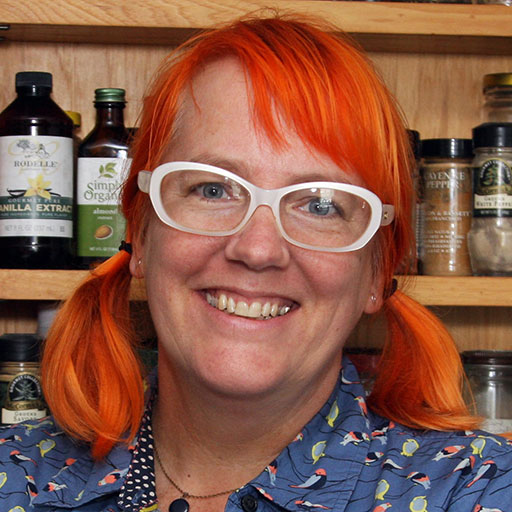Kayte Young
From WFIU in Bloomington, Indiana, I'm Kayte Young, and this is Earth Eats.
Stephanie Solomon
She introduced me to Susun Weed's books, and chickweed is in one of the herbal healing books. And it's talked about as this star shaped plant that kind of dances, like that that's its energy. [LAUGHS]
Kayte Young
This week on our special series, Earth Eats Eats Wild, we'll be talking chickweed with Stephanie Solomon, preparing purple dead nettle deviled eggs, harvesting ramps in the woods with Jill Vance, and frying up crunchy fritters made with dandelion flowers. All that wild food is just ahead. Stay with us. Whether you're hiking in the woods, weeding your garden, or walking downtown, there's almost always something edible growing nearby, especially in the springtime.
00:01:11:06
I'm Kayte Young, and this is the second episode in our series, Earth Eats Eats Wild, exploring the wild foods that surround us. In this series, we hope to introduce you to a few of the plants and mushrooms that you're likely to encounter, offer tips on how to identify them, talk about what they taste like, and share ideas for how you might prepare them in your own kitchen. Each season has its particular offerings. Let's start with one of the earliest edible greens.
00:01:55:27
Stephanie Solomon
It does really well in garden soil, so often, like early in the season, it's where you're healthiest, like, light, fluffy soil is. But then it's also like in the woods among trees, in really, like, nutrient rich soil.
00:02:12:15
Kayte Young
Job ID: 81803955 Earth Eats WFIU
Eats Wild ep 2_pod
That's Stephanie Solomon. Most people these days call her Solomon. And we're walking around my neighborhood looking for chickweed.
00:02:20:29
Stephanie Solomon
Oh, here it is. Oh my gosh. Okay. So this is awesome because one of the things that Lucille taught me early on was that one of the biggest harms that we do is to have these monoculture lawns. And when we get rid of any diversity in our lawns, we're getting rid of, like, all this food and medicine. So of course, it is, like, near the sidewalk, there's a cigarette butt, there's, like, a sign.
00:02:52:00
And that is where we find some, like, kind of nice soil with beautiful chickweed growing.
00:02:59:21
Kayte Young
Solomon mentioned Lucille. That's Lucille Bertuccio, and we'll hear more about her in a few minutes. For now, let's focus on this patch of dirt on a street corner near where the hospital used to be here in Bloomington, Indiana. And it looks like there's a bunch of other stuff right here, just, like, within your arm's reach.
00:03:26:03
Stephanie Solomon
Oh, this is fun. So I see some ground ivy or gill over the ground. Some purple dead nettle. I'm seeing some wild onions that you use like chives. So this is like a really, I don't know, just like a great edible patch. Some plantain.
00:03:45:09
Kayte Young
It's so crazy because there are three little tiny purple flowers blooming right now in our yard. So there's the ground ivy. There's the henbit and the purple dead nettles. And so they're all kind of close to the ground, and I feel like they are easy to confuse. But once you know, they're quite distinct.
Stephanie Solomon
And also, purple is my favorite color. And as a gardener in the Midwest, going through winter and then having all these wild edibles and wild plants with purple flowers come right up in the spring is a true delight. I love it.
00:04:31:12
Kayte Young
Okay, so let's talk a little bit about chickweed.
00:04:34:24
Stephanie Solomon
Okay. Oh my gosh. So the reason that it got its name is because chickens really like it. So it was like a weed that you could feed to your chickens, nutrient dense and just quickly gobbled up. The flowers, which are just starting like they haven't opened yet, but you can see the buds, when they open are star shaped. And so part of the scientific name is Stellaria, which means star, which I always thought was, like, fancy and kind of royal.
00:05:05:05
Chickweed, a lot of people will eat it early in the season. It tastes good while it's cold. Kind of like our cold crops, like, you know, kale and mustard greens do. But also because the older that it gets, the tougher the stem gets.
00:05:25:14
Kayte Young
What would you say it tastes like?
00:05:28:15
Stephanie Solomon
I think I've always said to people that it tastes like lettuce, but the reason why is because it's one of the few edible wild plants that isn't bitter. It's pretty mild. And so if you're new to eating edible wild plants, chickweed is a good place to start because the texture is, it's not super noticeable. It's not really chewy. It's like it goes down easy. It's pretty mild. It has a nice but not too noticeable flavor.
00:06:01:19
So people might put it on a sandwich. You might make a salad with it. It's not one of those that, like, you need to cook it or, like, put it in a griddle cake or, like, do something to it in order to enjoy it.
00:06:17:07
Kayte Young
How would you identify that if you were looking at it? What are some of its characteristics visually?
00:06:22:08
Stephanie Solomon
Well, it's very pretty. It has a rounded stem and this one has almost a purplish hue on the stem. And then it has these cute little leaves and they're right across from each other and these little green leaves, but they're different varieties of chickweed. So sometimes you'll find the teeny tiny ones, and then sometimes you find the really wide leaved ones, which feels like extra exciting for when you're going to be eating them.
00:06:55:15
Kayte Young
And there's sort of an almond shape, like, they kind of have a pointy tip.
00:06:59:10
Stephanie Solomon
Yeah, I like the clusters of the flowers at the top even before they've opened.
00:07:06:12
Kayte Young
Oh, and there's a little bit of space between each set of leaves.
00:07:10:14
Stephanie Solomon
Yes. And what I love about when you build a relationship with a plant, especially one that you find
tasty and have been eating for years, is that you almost can sense it. So, like, in this group of plants, the green of the chickweed is just a little bit different. Like a little bit brighter. There's a little bit more, [SIGHS] I don't know, there's almost like a little bit more white. Like, it's a different shade of green than the rest of the green.
00:07:43:07
Kayte Young
It has kind of a sheen on it, I feel.
00:07:45:16
Stephanie Solomon
I almost wanted to say it was glittery, but then I was like, that's going too far. [LAUGHS] But it's not just chickweed. There are a couple of plants that I feel like I'm so excited when it's their season that they jump out at me and chickweed's color, but also the way that it grows. It has almost like a center, and then it grows out and it's a circular plant and it has these beautiful stems that kind of reach out from the middle and reach up.
00:08:18:24
Kayte Young
Since you can't see Solomon, her arms are swiveling out [LAUGHS] and swerving around in kind of like a vine to describe how the chickweed grows.
00:08:34:15
Stephanie Solomon
I'll admit, my mentor who introduced me to wild edibles, Lucille Bertuccio, who I miss and I feel like I get to connect with when I talk about wild edibles, so much of what I'm saying and so much of my passion comes from her. She introduced me to Susun Weed's books, and chickweed is in one of the herbal healing books, and it's talked about as this star shaped plant that kind of dances, like that that's its energy.
00:09:10:26
[LAUGHS] And there's a part of me that's still kind of holds that, even though so much of my way of
thinking about plants has gotten a little bit more pragmatic over the years.
00:09:23:16
Kayte Young
That's really nice, though. It's a great way to identify it. And also just to talk about that relationship that you have with the plant.
00:09:30:05
Stephanie Solomon
Yeah. So I came to Bloomington to go to IU in the year 2000 and I took David Haberman's Religion, Ecology and the Self class. And Lucille sat in on the class. I mean, she had years and years of being an environmental activist and learning about wild edible plants, among other things. But I was new to all of it, and she was teaching a class the next semester, and I started joining her edible wild plant walks and learning that plants, you know, I grew up in the suburbs, I didn't think much about the plants around me.
00:10:13:28
And the way that Lucille talked about the plants was very much embodied, that they were among us. It was almost like there was a filter that was taken off for me, where I had been walking by these beautiful plants, living in the Midwest my entire life, whether I was in the suburb I grew up in, in the city, or in the woods, and just not noticing. And as soon as I started to learn, now it's like I can't walk by any natural place, or even through a city without noticing, like, look at this gorgeous plant growing in the cracks of the cement.
00:11:00:16
Kayte Young
So let's get back to the chickweed. I gave it a taste, and it is a lot like lettuce. Not just in the flavor, but also in its crisp, crunchy texture. I love lettuce. I know some people might think it's kind of plain, but I love it. And I especially love it this time of year.
00:11:17:20
Stephanie Solomon
Lettuce is a vehicle for so many amazing flavors that you wouldn't experience if you didn't have the
lettuce, and I think that in some ways chickweed was that vehicle or gateway for me because it was the first edible wild plant that was so easy to find and so mild, as my palette was, you know, adjusting to all the different bitter and intense flavors of edible wild plants. So another plant that really makes me think of Lucille is dandelion.
00:11:57:25
One of her most passionate arguments was how horrifying it was that we put chemicals into our lawns to get rid of dandelions. She would call them dandelion, the French term for dandelions, and talked about how every single part of the plant is edible and would make dandelion wine. She would make fritters out of the flowers. She would make tea out of the root. Early in the season, she would cook with the greens.
00:12:33:16
Some people even eat a salad with the greens. But it just kind of depends how old they are in terms of how bitter they're going to be. But then even the stem, it has this whitish interior, this liquid that is known to be medicinal. So it's like this beautiful plant that is offering so much to us, and yet we poison it and get rid of it.
00:12:57:20
Kayte Young
It is a perfect example because most people can identify it, and people who like pristine lawns are trying to get rid of it.
00:13:04:24
Stephanie Solomon
Yes. [LAUGHS] Yes. I have had neighbors that dig up or put chemicals to remove their dandelions and it's just very, very sad.
00:13:17:20
Kayte Young
While it was romantic and almost magical to stumble upon all of these edible plants on a street corner, I wanted Solomon to talk more about what to keep in mind when engaging in urban foraging.
Stephanie Solomon
So I think there is a metaphor to the fact that chickweed and all these edible and medicinal wild plants are growing on the corner of two streets that are pretty active and I love it and it's beautiful. But if I'm harvesting for myself, I want to find a place where I really think through, okay, what is the health of the soil here? What's the traffic like? Do I know if this person is using chemicals in their yard?
00:14:03:05
Am I certain that I have correctly identified the plant? So there are a lot of things, especially for folks who are new, that when I go on wild edible walks that I'll bring up. I think the metaphor of the city wild edible is a gorgeous one, but also needs attention that you don't need when you're in someone's organic garden and there's a ton of chickweed that you can just immediately eat right there.
00:14:34:15
Kayte Young
So by the metaphor, do you just mean like the way that these nutrient dense kind of healing plants are growing in these kind of damaged spaces or urban spots?
00:14:45:08
Stephanie Solomon
Yeah. So people could be walking to work or just driving by and not even notice that there's onions and mints and chickweed and all these plants that have these properties to them.
00:15:07:26
Kayte Young
In our first episode of Earth Eats Eats Wild, we spoke with Monique Philpot, founder of Soulcraft Bloomington Forest and Folk School. She teaches the Edible Wild Plants class at Indiana University that Lucille Bertuccio taught for years. Solomon has also taught that class and educated people in the community about gardening and wild food through The Hub, a community food resource center, the city parks and rec programs and more.
00:15:36:11
Stephanie Solomon
I have taught wild edible classes myself. I originally learned from Lucille, she would come every year to Mother Hubbard's Cupboard, where I worked, and offer a free community workshop in all different places with all different people, which was delightful. But she was also at the same time, every spring semester, teaching an edible wild plants class at IU, and at the time that she got sick, she had a class coming up out of Collins Living Learning Center on edible wild plants and asked if I could fill in for a semester.
00:16:17:15
And I was so excited because I love edible wild plants, and I loved the idea of getting to bring some of that energy that Lucille had brought to me around love for wild plants to young people who are excited to learn about it. She ended up passing away during that time. So I continued for a while to teach the class. And it was a really important experience for me, both because I had to learn on a deeper level about botany and about these plants that I had loved but loved as a gardener, loved as a person who enjoys food, but hadn't really loved in a way that was precise enough to teach people to safely identify and eat.
00:17:15:02
But then the part that sticks with me more, it's been years, is that I had the opportunity to grieve the loss of a mentor and friend by sharing the knowledge that she had given to me and to so many people in our community to a group of young people. And I came in with these, you know, stereotypes about they were just going to be on their phones and how was I going to keep them interested? And it it was not that way.
00:17:55:24
They came out with their notebooks and I felt Lucille with us all the time, just the joy of watching young people see their first red bud and taste it like, take it from the tree and taste it and get wide eyed and, you know, come back to class and draw it or write a paper about like the health benefits of it. And it helped me understand just this undying joy that Lucille had for young people, adults, especially in a college town.
00:18:32:14
You know, they have some valid concerns about young adults but Lucille never wavered in her belief that the more young people that got invested in the planet, whether it was through wild edibles, through learning to garden, through getting involved in saving trees, that they were really where our hope was. And I experienced that myself, working with IU students who fell in love with wild, edible plants in the same way that I did.
And so just another layer of Lucille's presence that I got to experience even after she was gone.
00:19:17:11
Kayte Young
Lucille Bertuccio was an environmental activist, educator, and co-founder of the Center for Sustainable Living, a nonprofit organization here in Bloomington that supports the development of community based, self-organized and sustainably oriented projects. Lucille inspired those around her by sharing her knowledge on gardening, wildlife and ecology, and also in the way she lived. She chose walking as her primary mode of transportation, and encouraged wild native plants to flourish in her diverse and decidedly untidy garden.
She taught organic master gardener classes, wild edible plants at Indiana University and Mother Hubbard's Cupboard, and she served as executive producer of Eco Report on WFHB Community Radio. Her legacy lives on in the community through the students she taught and through everyone she mentored and inspired to build connections with the natural world and to protect wild plants, animals, and the spaces they inhabit.
00:20:20:00
Lucille Bertuccio wasn't Solomon's only mentor.
00:20:24:13
Stephanie Solomon
I got very lucky as a young adult at IU Bloomington in having unbelievable mentors and just like the dandelion and the ground ivy and the chickweed make me think of Lucille, burdock makes me think of Leah Garlotte, who was the director of Hilltop Garden and Nature Center and taught me how to garden organically. And burdock is not only beautiful, but super tasty, and you can make tea out of it.
00:21:03:18
She helped really connect those dots between why it was important to grow food organically, to grow native plants and learn about them, but then also be learning about wild plants that were
invasive and the ways that we could use them, and the ways that we could best tend to the land that we were on and understand it and build a relationship with it. I don't know how I got that lucky to meet both of them at such an important time in my life, and to have them offer me the wisdom that they had for years and years, both of them, of studying ecology and plants and environmentalism.
00:21:47:14
And I just soaked it all up, soaked it all up. So I can say a little more about burdock. I was that kid that got excited enough about edible wild plants that I wanted to grow them myself and burdock is one where you actually kind of have to because if you try to dig it up where it's growing, which you can see here, it's growing within gravel. So it would be really tough to dig up this burdock, and you would probably get just a teeny bit of the root.
But if you grow it in your garden in light, fluffy soil, the roots will get big. And then you can saute it, you can dry it, you can make tea out of it. But then if you leave it and just enjoy it, it makes these beautiful flowers. So win-win.
00:22:36:03
Kayte Young
And those seed pods that are kind of strange, they have a burr on them. I guess that's where it gets its name.
00:22:42:08
Stephanie Solomon
Yes, it hurts my feelings when people don't appreciate the burr of the burdock because it is such a beautiful, important plant that gives us so much. And I mean, it's a wild looking flower. It's definitely nature giving us some art to enjoy as we move.
00:23:01:15
Kayte Young
I'm going to have to check it out this year. I'm one of the people who doesn't appreciate burdock.
00:23:06:11
Stephanie Solomon
How dare you!
00:23:09:11
Kayte Young
I don't like it when it shows up in my yard because of how hard it is to dig out.
00:23:14:18
Stephanie Solomon
13
Yeah. So when it shows up and you don't want it, it is not a well-loved plant. But when you grow it in a place where you know you can harvest it, it's delightful.
00:23:31:16
Kayte Young
That was Stephanie Solomon singing the praises of burdock and of her mentors, the late Leah Garlotte and Lucille Bertuccio, who inspired her to build relationships with the plants around her. We won't be cooking with burdock root in this episode, but we will explore the culinary possibilities of a couple of other common weeds that Solomon mentioned, including purple dead nettle. After a quick break, we'll walk through the steps of a wild scented recipe for deviled eggs.
00:24:00:24
Stay with us for more of Earth Eats Eats Wild. We're back. I'm Kayte Young, and this is Earth Eats Eats Wild.
00:24:28:25
Kayte Young
I am so excited right now because I have just learned, from a newsletter called The Wild Grocery, that dead nettles, which is a weed that is all over my garden all the time, is edible. I'm going to harvest some and check it out. Dead nettles. So-called, I think, because they're not stinging nettles, but they don't look much like nettles. In fact, it's actually called purple dead nettle, and it's a common weed in most yards and gardens in the Midwestern United States.
00:25:12:24
The leaves are sort of a muted green with a purple tint. They're triangular and they're fuzzy. The leaves grow along a square stem, almost like they're stacked in a tower with the leaves getting smaller towards the top. Tiny purple flowers poke out between the leaves when it's in bloom, and the whole thing is edible. This is a weed that I have been seeing in my garden for years and years, and pulling it out, and tossing it, and not realizing that it was an edible plant.
00:25:49:07
And so I'm excited to try it and see what it tastes like and see if it's something that I want to cook with in the future. Some characteristics of dead nettle are that they have kind of a fuzzy, scalloped leaf, kind of a heart shape, if you turn it upside down a little bit. The leaves are opposite each other on the stem. They don't alternate along the stem. Another characteristic is that the stem has that kind of square shape.
00:26:21:05
It's got flat sides that is characteristic of the mint family, and dead nettles are in the mint family. It's my understanding that the top part of the nettle plant where the flowers grow is the more pungent- tasting part of the plant, and so a lot of people don't really like it. I have never tried it, so I'm going to give it a try. Now they say it's strongest when it's raw. So when you've cooked it, it's not going to be this pungent.
00:26:52:14
So I'm going to try it raw just because I want to know what it tastes like. I like it. I mean, it definitely has that kind of earthy, herby flavor, but I like it. It's fine. I don't find it offensive in any way, and I think it's going to taste good when it's cooked. If you're concerned about that kind of funky, pungent flavor, it's best to avoid the top of the plant and just use the kind of larger, outer leaves. 00:27:17:28
And so pick those off of the stem and collect enough so that you can have about a cup full of these larger leaves that you're going to cook. We're going to cook these just like we might spinach or some other green, except we're not going to saute them; we're just going to cook them in some water, some boiling water, and then we're going to chop them up and mix them in with a deviled egg mixture.
00:27:40:19
Be sure to save some of the purple flowers as you're trimming the leaves off of the stem, and save some of those purple flowers. We can garnish the top of the deviled eggs with those. It's going to
look really nice. Even if dead nettles don't end up becoming like one of your favorite plants to cook with, I think having the experience of noticing it in the environment, harvesting it, processing it, cooking with it, tasting it is really valuable because it familiarizes you with the plants that surround you every day and just raises that awareness of, oh, there's all this edible food around us. 00:28:32:06
If you're ever in a position where you might actually need to be harvesting wild food in order to survive, having that familiarity, having that experience of like, "I have picked this, I have cooked this, I have tasted it, I know what it is," that experiential knowledge is just priceless. Okay. So I've washed the dead nettle leaves, and now I'm going to bring a small pot of water to boil, and I'm just going to boil them for a few minutes.
00:29:14:24
Once your water is boiling, just toss your one cup of washed dead nettle leaves into the pot and let it boil for, I don't know, two to three minutes. You just want them to be tender. Don't need to overcook them. Once you've cooked the greens for two or three minutes and they're tender but still bright green. Strain the leaves in a colander and press out the excess water. After you've strained the leaves and pressed out all the excess water, you want to chop them finely.
00:30:01:29
And then you can mix them in with your favorite deviled egg mixture, or you can follow the recipe that I'm going to share online. I'm going to mix in a few special ingredients, including artichoke hearts. But before I mix these leaves in with my deviled egg mixture, I just want to taste them, now that they've been cooked, and see what I think of the flavor. Honestly, it tastes a lot like spinach. 00:30:33:21
That's what I would compare it to. It's got that nice green earthy flavor, but there's nothing pungent about it, there's nothing funky. It just tastes like spinach. For the complete deviled egg recipe, visit our website eartheats.org or just throw some finely chopped boiled dead nettle leaves into your favorite recipe and garnish the eggs with those delicate purple blossoms that we set aside at the beginning.
00:31:10:23
It's a stunning presentation and a conversation starter for sure. As I have mentioned a few times already, this is a special miniseries called Earth Eats Eats Wild. The truth is Earth Eats has featured wild food and foraging many times over the years. Our founder and original host, Annie Corrigan, went out in the woods in the spring of 2016 and produced this piece.
Annie Corrigan
Spring foraging is all the rage these days. Wet and warm weather has morel lovers putting on their boots and grabbing their mesh bags in the hopes of hitting it big in the woods. But then there are people like Jill Vance. Maybe you can relate.
Jill Vance
I have never loved the taste of mushrooms and I just don't have an eye for them either. I can step in a patch of morels and not see them.
Annie Corrigan
Jill spends a lot of time in the woods looking for other goodies, most of which are easier to spot than camouflaged mushrooms. She's the Interpretive Naturalist at Monroe Lake, and one of the wild edibles experts on staff at Indiana's Department of Natural Resources. I met up with her this week for a foraging expedition to highlight some of the other wild foods that thrive in the spring.
00:32:36:18
Jill Vance
We are right off of the Monroe Lake Dam, across from the Army Corps of Engineers office. So we are in the southwest portion of the lake.
00:32:47:11
Annie Corrigan
I wore my heavy duty jeans and some sneakers that I use to mow the lawn. They have mesh, so that might have been stupid. Well, but your shoes have mesh.
00:32:54:16
Jill Vance
Mesh is fine. Yeah.
00:32:56:16
Annie Corrigan
Let's do it. I'll follow you.
00:32:57:18
Jill Vance
All right, let's go.
Annie Corrigan
And the woods are glowing bright green with lots of new growth. We walk maybe 20 paces on the trail, and then we stop.
00:33:10:02
Jill Vance
All right. This is a very common understory little shrub that you find in a lot of the woods in this area, and it's called spicebush. And if you look, we're in a little group of them here And you can see how they kind of the stems sort of arch over, which gives them kind of like a little umbrella-like shape to the shrub itself. And if you crush the leaf up a little bit and then smell it.
00:33:37:21
Annie Corrigan
It's lemony.
00:33:38:29
Jill Vance
Very distinctive, yes. We get a variety of descriptions for what it smells like. My favorite one is little kids will tell you it smells like Froot Loops. Not like Froot Loops in your bowl, but if you open a box of Fruit Loops and you stick your nose into the box and you get the overwhelming aroma, it does have a very lemony, almost a citrusy kind of smell to it. But spicebush is very common.
18
Job ID: 81803955 Earth Eats WFIU
Eats Wild ep 2_pod
00:34:03:05
It's a nice wild edible because it's actually year-round. Primarily, it's a tea plant. This time of year, the leaves are still nice and tender and really well into the summer the leaves are still pretty good for this. You can gather the leaves or you can gather up the little twigs, and the twigs are year- round. So if you learn to recognize this plant, you can come and gather the twigs, you know, in the middle of the winter, and you stuff it all in a little saucepan and cover it with water, and boil it for a little bit, and then strain out all the leaves and stuff, and you've got a little tea right there, spicebush tea, and sweeten the taste.
00:34:41:16
And then going on to a later part of summer, the spicebush will also produce a little hard red berry. And those red berries, you can take those off, you can dry them and crush them into a powder, and it's a substitute for commercial allspice.
00:34:58:11
Annie Corrigan
Now we leave the trail, which Jill says is okay in an Indiana State Recreation Area, but don't assume that's okay everywhere. She says it's important to know the rules of the place you'll be visiting. All it takes is a quick phone call to the manager of the land to make sure you're doing everything by the book. A little further into the woods and halfway down a slope we spot a darling of spring foraging.
00:35:22:15
Jill Vance
I was so happy to find these.
00:35:24:03
Annie Corrigan
Holy moly, is this what I think this is?
00:35:26:13
Jill Vance
I don't know. Depends what you think it is. [CHUCKLES] Is it ramps?
00:35:29:23
Annie Corrigan
It is ramps.
00:35:31:06
Jill Vance
But yeah, ramps are kind of a trend food, and that's a good thing and a bad thing. It's good because it helps people appreciate what we've got here naturally. It's a bad thing because these guys do not reproduce very quickly on their own, and a lot of the wild populations have just been decimated by the trend-seekers who want to come out and get a lot of them. I'll get one out of the ground here.
00:35:57:08
And see a little onion-like bulb here. I will actually be replanting this one. I mean, it looks like there's a lot here, but there really aren't. You could imagine if somebody came out and harvested these for a restaurant, they could wipe out this entire population in one go, and that would be it. That's all we would see with ramps here. And the trendy way to prepare ramps is to use the whole plant, and they want to see the bulb and the stalk.
00:36:30:05
Well, that's great, but without the bulblet there, these guys really struggle to rebuild their population. And there's no reason that you have to take the bulb. What you can do is you can come in these plants and you could just slice off. The leaves are perfectly good, they work exactly the same way, give you the same flavor, and harvest responsibly. Don't take all the leaves, take a portion of the leaves.
00:36:53:04
Annie Corrigan
And then Jill did tuck the ramp bulb back into the ground. At the end of our day together, Jill Vance spread out ten different books on her car's hood. She breaks them down into three categories: basic plant identification books, wild edible ID books, and then recipe books. It's important to take
one or two identification books with you when you look for wild foods because if we could make a list of rules to live by when foraging, number one would always be know your plants.
00:37:31:14
And then after that...
00:37:33:09
Jill Vance
Make sure you have permission to harvest. Make sure you know what you're harvesting, make sure you know how to harvest it and how to prepare it. And then also make sure that the area you're collecting from has not been treated with chemicals.
00:37:45:10
Annie Corrigan
And just as important, harvest sustainably. A good rule of thumb, I've heard, is to pick no more than 10% of any one patch.
00:37:53:24
Jill Vance
You know, if you enjoy these things, you should want them to return. And so you should learn how to do that.
00:38:01:18
Kayte Young
Jill Vance has been an Interpretive Naturalist with Indiana State Parks since 2004. That story was produced by Annie Corrigan way back in 2016. Foraging for ramps has only increased in popularity since then, so it's more important than ever to follow the sustainable practices that Jill mentioned. Just harvest the leaves, keep the bulb in the ground, and don't take more than 10% of any patch you find.
00:38:26:23
Learn more on our website eartheats.org. Kayte Young here, and we're back with Earth Eats Eats Wild. We're heading back outside into my yard again, and this time we're looking for something that's a little more familiar. When we talk about foraging for wild food, this might be the plant that
first comes to mind. In the spring, you can almost always find dandelions in your yard, in your neighbor's yard, just along the sidewalk as you're walking in parks.
00:39:09:03
Dandelions are everywhere. And generally speaking, no one is going to mind if you pick some. They start showing up mid-March, I'd say, around here. You'll also start seeing violets around this time. And all we want here is just the flower. You're just grabbing the very top of the plant, just popping the flower right off of there. Not trying to save any stem or anything like that. Of course, people do eat dandelion leaves as well.
00:39:47:00
Today we're just going to focus on the flowers. All right. I've got about 25 or so. Let's head inside. Of course, as with anything that you're harvesting from outside, you do want to go ahead and rinse it off in the sink. And I'm just using my salad spinner for this. That way we can get them dried off really nice. Okay. And then you want to prepare two, just like you're batter-frying some wild mushrooms or I don't know what else you would do this with.
00:41:02:25
Fish. So many different things. In fact, I have found that most things taste pretty good when you batter and fry them, so that's what we're going to do with these dandelion blossoms. We're going to start with one egg mixed with milk. Just a splash, just to kind of thin it out a little bit. And then I put a little bit of salt and pepper in that as well. And we're just mixing that to blend it and break up the yolk.
00:41:41:12
We're not trying to beat a bunch of air into it or anything like that. And then we're going to take a little bit of flour and put that on a plate. Just all-purpose flour. You could mix a little bit of cornmeal in there if you like. And then about a half teaspoon or so of salt and a few grinds of pepper. And whenever you do this kind of battering and frying, you want to kind of set up your station and have the bowl with the egg in it.
00:42:14:17
And then next to it, you want the plate with the flour mixture on there, and then get yourself a pan heated up. I'm going to be using a cast iron skillet. I think you definitely want a heavy skillet when you do this kind of frying. Medium high heat, and we're going to use a neutral oil for this. You definitely don't want to use anything that's got a low smoke point. So we're going to use sunflower oil.
00:42:46:26
When you do this kind of batter and fry method, you want to keep your wet hand and your dry hand. So you're going to drop your dandelions into the egg mixture with your wet hand. And actually, in this case, we can use the stem of the dandelion flower to hold on to it, and we don't even have to get our hands into the egg mixture. So the procedure here is to take each dandelion flower and dip it flower-side down, like, just the face of the flower.
00:43:24:07
The yellow part is going to go directly into the egg. And get it coated, and then place it on top of the flour mixture and just really dust it around, kind of like you're mopping through the flour. Get it coated really well, and then set it on a separate plate and get them all ready so that you can fry them all at once. Dip flower into egg. Dip flower into flour. Put flower on plate. Repeat. Dip flower into egg.
00:44:04:23
Dip flower into flour. Put flower on plate. Repeat. The other way that you can do this is drop the flowers into the egg mixture, kind of mix them around so they're coated, drop them into the flour mixture, and then just kind of mix them around with a fork until they're coated. You can do several at a time that way. Oh, man. Oh, I didn't follow the dry hand, wet hand thing, and now my hands are all gummy with the flour and the egg.
00:44:46:01
Ugh. Okay. But I'm all done. I've got batter all over the dandelion flowers, and I'm ready to start frying. Just got to wash my hands first. All right. And we want to get our oil nice and hot. I've got it at a medium high heat, and I think it's best to get your plate really close to your skillet. And we're going to place these into the hot oil, blossom-side down, so they're like a little hat or something. 00:45:16:00
And you're holding on to the top of it, where that stem is, to place them in there. And if it starts smoking a little bit, you just want to turn the heat down. The flower is going to burn a little bit; it's going to make some smoke. Don't worry too much about it. If the fire alarm doesn't go off, are you really cooking? This is something that is so fun to do with kids because they love picking the dandelions.
00:45:56:09
It's really fun to just go out there and gather as many as you can, and then come inside and batter them and fry them. And as with anything when you make it yourself, you're more likely to try it,
you're more likely to like it. All right. So once they get a little brown, then you're just going to take them off and set them on a paper towel to drain. A pair of tongs is really handy for this. 00:46:29:28
So these will start to brown up pretty quickly on one side, and once they've done that, flip them over and kind of press them down so that the other side gets a little brown as well. They really only take a couple minutes. Now that I'm doing this, I'm going to suggest that you do it in batches because they do cook pretty quickly and you want to be able to monitor each individual flower so that they don't get too brown.
A couple of mine got too brown on one side, but that's okay. I bet they're still going to be pretty good. And then you just want to brown the stem side just for a couple of minutes as well. At this point, I have it on medium heat. I felt like the medium high was causing it to smoke a little too much. All right. So I think these are done. You can take them off and place them onto a plate. You can put a paper towel under that if you want. You don't have to.
Taste them. If they need a little salt, sprinkle them with salt and you're ready to serve. Oh, they're really cute. I'm noticing that the ones that were really big fluffy flowers have just turned out really nice-looking. You can kind of distinguish the little petals of the dandelion. So they look really nice. They have a little bit of a crunch to them. You know, they have some a little crispy, some of them. 00:48:02:16
And let's give one a try. Oh, they're hot. Gotta wait a second. Oh, yeah, they're very cute. So you can see why they're called fritters, too. Because they have that kind of fried, smashed look to them that really does remind me of a fritter. All right. I think this one's cool enough to taste. I love these. I mean, you're getting, of course, the fried batter, which tastes like you would expect it to, but it's got more to it than that.
There's a little bit of sweet nuttiness to the petals, to the yellow part of the dandelion, but then the part that's green does have a tiny hint of bitterness, which I'm really enjoying. I think it's really nicely balanced with the other flavors and textures of these fritters. There you have it. These are best eaten directly after cooking them. Don't let them sit around. They're going to be tasty right off the griddle. Enjoy.
Kayte Young
You can find this recipe for Dandelion Fritters on the Earth Eats website eartheats.org. That's it for the show this week. Join us next time for our third and final spring episode of our special series Earth Eats Eats Wild. We'll be searching in the woods for the elusive morel mushroom, one of the most beloved of the wild foods in springtime, and we'll explore the mind-blowing flavors of the spruce tree and talk with Forager Chef Alan Bergo about when to harvest spruce tips and what to do with them.
Remember to always do your research before consuming wild plants. Consult a reputable foraging guide for identification or go out with an experienced forager. We have links to resources on our website eartheats.org. Be sure to check out our social media, @Earth Eats, for bonus videos and photos featuring tasty wild spring plants.
The Earth Eats team includes Eoban Binder, Alexis Carvajal, Alex Chambers, Toby Foster, Luann Johnson, Leo Paes, Daniella Richardson, Samantha Schemenauer, Payton Whaley and we partner with Harvest Public Media. Special thanks this week to Stephanie Solomon, Annie Corrigan, and Jill Vance. Earth Eats is produced and edited by me, Kayte Young. Our theme music is composed by Erin Tobey, and performed by Erin and Matt Tobey.Additional music on the show comes from Universal Production Music. Our executive producer is Eric Bolstridge.







